Commonly Grown Mushrooms
Commonly Grown Mushrooms
There are literally thousands of species of both edible and medicinal mushrooms, in all of the colors of the spectrum and then some. From buttons to Chagas to chestnuts and more, the choices of what you’d like to grow are wide indeed. In this lesson I’m going to discuss some of the more commonly grown mushrooms. I encourage you to dig deeper!
Oysters (Pleurotus spp.)
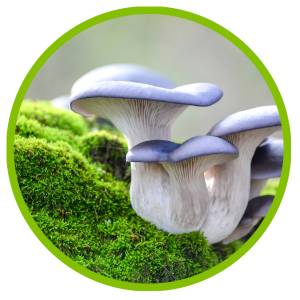
Blue Oyster
Pink ones and blue ones and orange ones, oh my! King and black pearl, grey dove, golden and Phoenix. Oyster mushrooms are a very diverse genus, generally easy to grow, and very prolific. Some strains, such as blue and pearl oysters, prefer cooler temperatures whereas others, such as pink, golden, and Phoenix like it a bit warmer. They’ll grow on a variety of substrates, including sawdust, straw, coffee grounds, and even toilet paper rolls! With the exception of the Black Pearl oyster, these are considered among the easiest to grow and a great choice for beginners. Nutritionally they have a very high protein content, ranging from 13-35% by dry weight, and high amounts of free amino acids. They also contain varying amounts of B vitamins and vitamin C. Exact amounts depend upon which strain and a number of other factors.
There are some disadvantages that should be noted. One: they don’t keep well, not more than a few days. Two: they generate a huge amount of spores and can be a health hazard in the grow room during spore release. Three: they attract flies more than any other species. Since flies are a contamination vector, the flies are a problem and must be dealt with.
The myceliated waste straw produced by growing oyster mushrooms has a variety of uses: livestock feed and environmentally safe but effective nematocides. It can also be used to grow wine caps.
Medicinal Uses
Studies are very preliminary, but evidence is mounting for their use as immunomodulators and their ability to lower both cholesterol and blood sugar. For more in-depth information, please consult a good reference regarding specific species of interest.
Shiitake (Lentinula edodes)
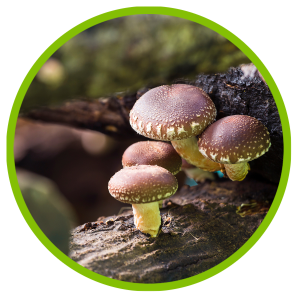
Shiitake
These are native to Asia and the second most cultivated mushroom in the world. While they prefer hardwood logs such as oak, maple, ironwood, and beech, it’s not all at impossible to grow them indoors on supplemented sawdust. My experience with growing them on straw was it’s not really worthwhile. They’ll colonize easily enough but I didn’t get many fruits this way. These prefer higher temperatures for incubation, 70-80 F, and lower temperatures for pinning and fruit body formation in the 50-70 F range. Nutrition content: high in protein and several B vitamins, fiber, potassium, and magnesium.
Culinary Uses
In addition to combining them with lion’s mane as described below, shiitakes are a great addition to just about everything. Soup, pasta, and dried as jerky, in both quiche and pate, shiitake are extremely versatile and will add a wonderful flavor to just about any dish.
Medicinal Uses
Lentinan, one of many polysaccharides in this mushroom, has been shown to have anticancer properties and is an approved drug in Japan. The KS-2 polysaccharide has been shown to suppress sarcoma Erlich ascotes in mice. Shiitake extract has been shown in early studies to stop the replication of the HIV virus. A lignin-polysaccharide fraction recently isolated has shown potent anti-viral and immunopotentiating properties. Lentinan has been shown to have antibacterial and cholesterol-lowering effects as well.
Lion’s Mane (Hericium erinaceum)
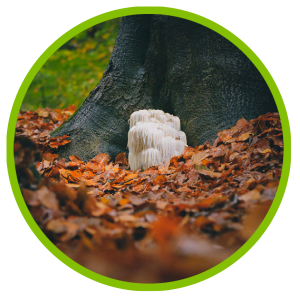
Lion’s Mane
This is a white snowball-shaped mushroom with its gills on the outside, looking like icicles. This is a good one to cultivate because it’s not often found in grocery stores, because it bruises easily. There are several related types under this common name, including Bearded Tooth and Comb Tooth. It grows best on supplemented hardwood, preferring temps in the 60-70 F range. If growing outdoors, hardwood and Douglas fir logs work well. pH range for fruiting 5.0-6.5. These did not grow on straw well at all, at least not for me. These are high in protein and carbohydrates, and also contain a good dose of fiber, potassium, and iron. All for only 35 calories per 100 gram serving!
Culinary Uses
Sweet, savory, seafood like texture. Very yummy when sautéed with garlic and butter! Can be mixed in with other vegetables for a lovely texture. You might consider sautéing these with Shiitake with a touch of soy or tamari sauce over white rice.
Medicinal Uses
Studies from China have proven lion’s mane effective on ulcers, tumors of the alimentary canal, and inflammations. This variety produces diterpenes (erinacines and hericinones) which stimulate nerve growth factors to regrow neurons. Hericium also produces unique types of beta glucans, which have many medical properties in addition to neuroprotection. Other benefits include both mood and blood sugar regulation, memory/cognitive function improvements, antibiotic and antioxidant properties, and many others.
Enokitaki (Flammulina velutipes)
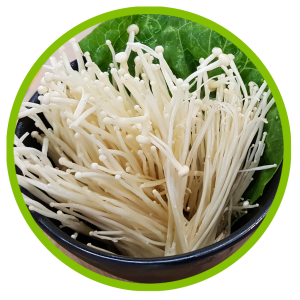
Enoki
AKA Enoki, these are a winter-fruiting mushroom when grown outside that will thrive on a variety of substrates. Enoki prefer cooler temperatures in the 40-50F range for pinning and 50-60 F for fruiting, but 70-75F for incubation. They’re often grown in jars or cylinders. When grown indoors, Enoki will have a long, leggy appearance since it doesn’t have the same access to sunlight as it would receive outdoors. Enoki can be grown outdoors on hardwood logs such as oak, alder, poplar, etc. It will grow on Douglas fir but the crop yield will likely be less. Nutritionally, they’re good sources of protein fiber, carbohydrate, and potassium.
Culinary Uses
A crisp, radish-like flavor that’s commonly used in soups and stir fries combined with vegetables, chicken, and fish.
Medicinal Uses
Flammulin, a polysaccharide, has been shown to have anticancer properties, effective against Sarcoma 180 and Erlich carcinoma.
Maitake (Grifola frondosa)
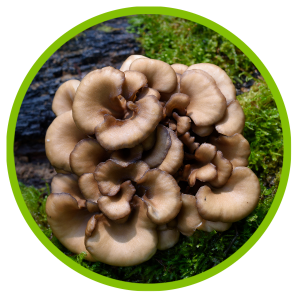
Hen of the Woods
AKA Hen of the Woods, this isn’t considered the easiest mushroom to grow. It is however, a fairly large shroom averaging 10-15 pounds, it’s well worth it! This is a polyphore that given its size, is best cultivated outdoors on a big stump or a buried log.
Hardwoods are the preferred substrate of course, and inoculation should be heavy to prevent competing fungi from crowding it out. Supplemented sawdust is also commonly done but obviously, the mushroom will be much smaller, only 1 to 1-1/2 pounds. The big trick here is dealing with the various stages of growth, from pins to fronds to fruits. It’s a beautiful mushroom and very tasty, but not the best for beginners unless you’re up for a challenge. Preferred temperatures range from 50-75 F depending upon which part of the growth cycle, cropping every 3-4 weeks for a maximum of 2 flushes. Nutrition: approximately 27% protein along with assorted B vitamins, vitamins C & D, and several minerals including magnesium, iron, calcium, and phosphorus.
Culinary Uses
Since the flesh is very meaty, it’s often served as a meat substitute. There’s always the sauté, and it can be stuffed with shrimp & other goodies and baked. Dried specimens can be powdered for tea.
Medicinal Uses
Studies at the National Cancer Institute show significant activity against HIV/AIDS, comparable with AZT. NIH Japan replicated this data. A polysaccharide called grifolin has shown strong anti tumor activity in mice against sarcoma 180, prostate cancer, cervical cancer, and leukemia. Maitake also has liver protective, immune enhancing, and both blood glucose and cholesterol regulating properties.
Buttons (Agaricus spp.)
 This is the common gray/white mushroom found in the grocery store. These can be grown indoors or outdoors and prefer a nice manure-enriched straw blend. Portobellos and criminis are types of button mushrooms, the former being Agaricus brunnescens. Temperature range from 60-77 F is preferred, with warmer temperatures for colonization of substrate and 60-65F for fruit body development. Portobellos are another mushroom that probably isn’t the best choice for beginners unless you’re up for the challenge, but can be very rewarding. The grocery store variety (A. bisporus) however, is much easier. Nutrition content is 25-33% protein, 9% fiber, and 10% ash. They are low in fat and have no cholesterol.
This is the common gray/white mushroom found in the grocery store. These can be grown indoors or outdoors and prefer a nice manure-enriched straw blend. Portobellos and criminis are types of button mushrooms, the former being Agaricus brunnescens. Temperature range from 60-77 F is preferred, with warmer temperatures for colonization of substrate and 60-65F for fruit body development. Portobellos are another mushroom that probably isn’t the best choice for beginners unless you’re up for the challenge, but can be very rewarding. The grocery store variety (A. bisporus) however, is much easier. Nutrition content is 25-33% protein, 9% fiber, and 10% ash. They are low in fat and have no cholesterol.
Culinary Uses
Almost too many to mention! Stir fry, soups, pizza oh my! Please note however that eating this mushroom raw isn’t recommended as neither the nutritional nor medicinal benefits will be realized, and there’s a danger from hydrazines.
Medicinal Uses
This mushroom inhibits aromatase, an enzyme associated with tumor growth. Therefore, it has potential anticancer activity. Those previously mentioned hydrazines are carcinogenic compounds that have been thought to denature from prolonged, high temperature heating, ie cooking. Research is still ongoing and controversial, so weigh the risks against the benefits carefully. Preliminary studies show decreased insulin resistance in people with type 2 diabetes provided they also make lifestyle changes, general immune and cancer support, liver and general hepatitis support. I cannot stress enough to use this species with caution however! Again, all studies to date are preliminary and still a bit controversial.
Wine Caps (Stropharia rugoso annulata)
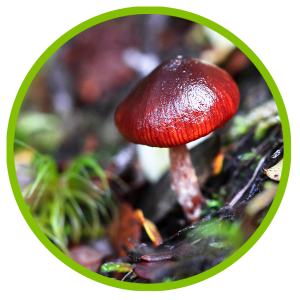
Wine Caps
These are a really pretty mushroom to behold with its burgundy red caps, and when grown outdoors tend to give great yields of good-sized shrooms. While they can be grown indoors, it’s a lot more effort for reduced yields. Therefore, outdoors in a mix of compost and straw are best for these.
Stamets’ preferred method of outdoor cultivation is to inoculate a pile of wood chips in spring, approximately 1’ thick with 5 pounds of a sawdust-chip spawn. Water it twice per day unless it rains, 1/2 hour morning and evening. They’ll tolerate huge temperature swings but optimal temps are 50-60 F for pinning and 60-70 F for fruit body development. Rhizomorphs can be detected in 2-3 weeks, with fruitings starting in late summer and continuing through early fall.
This mushroom is a great choice for bioremediation, but again, you won’t want to eat them if you’re using them for that purpose. While wine caps do contain small amounts of protein, calcium, and iron, their major nutrition value is in the lack of fat, cholesterol, and sodium. Very little is known about their medicinal properties. They can be cooked in stir fry and barbequed as one would a steak, but be warned: imbibing too many of these can adversely affect the gastrointestinal system. Preliminary reports suggest that this mushroom eaten in large quantities affects the stomach’s ability to produce digestive enzymes, so beware! Too much of a good thing can be a bad thing.
Reishi (Ganoderma lucidum)
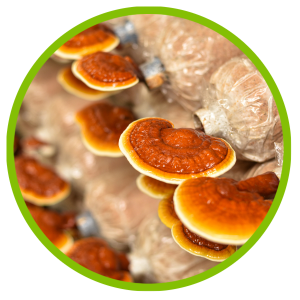
Reishi
Known as Ling Chi in China, this mushroom has a long history of medicinal use. There are yellow, red, purple, and black strains widely available on the market. This is an annual mushroom, similar in concept to other annual plants, so don’t count on harvests over the years. They certainly can be grown indoors on a hardwood sawdust/mixture inoculated into standard polyethylene bags, but it can take a few months to colonize and fruit especially if your grow room is a bit cooler.
At a specific point in the development of the antlers, the bag will have to be opened to dissipate the carbon dioxide that’s developed and stimulate conk development. They do need a high humidity level almost to the tune of a Gothic fog, so keep that in mind as you expose them. Asian cultivators inoculate cylindrical bottles or bags, pull out the cotton stopper when the time comes, and watch the stems elongate and the conks grow. Of course the exact process is a bit more complicated, so please consult a good reference if you want to try this method.
Reishi doesn’t have a lot of nutritional value; its value lies in its medicinal qualities. It’s usually prepared as a decoction for tea, but be prepared for a bitter flavor. Tinctures are also a good choice.
Medicinal Uses
Reishi has a wide range of effects. The beta glucans have been shown to have anticancer, anti-inflammatory, and anti-viral properties in addition to immunomodulating properties. It’s the natural medicine of choice for many suffering from immunological disorders. Reishi benefits the heart as well as regulating blood pressure/sugar and cholesterol levels. It benefits lungs, respiratory tract, and liver as well as having good effects on cognitive ability, anxiety, depression, and insomnia. There’s even evidence that it functions as a pain reliever. While I’m cautious of things that read like panaceas, I’m glad to see reishi being more extensively studied.
Review
Again, these are but a few of the many species widely available to the home cultivator. I tend to select which varieties to grow based on how I plan to use them and yes, whether or not I enjoy the taste. By researching the medicinal properties and culinary uses of the species of interest, it’s very easy to add layers to both your food and medical preps. Happy growing!
| Variety | Preferred substrate | Ideal fruiting temperature | Harvesting times |
| Lion’s mane | supplemented hardwood | 60-70 F | 8-10 weeks indoors
1-2 years outdoors |
| Shiitake | logs-hardwood | 50-70 F | 3 months indoors
1-2 years outdoors |
| Enokitake | logs-hardwood or supplemented sawdust | 40-70 F | 6-8 weeks indoors
6 mo-1 year outdoor |
| Maitake | supplemented hardwood | 55-65 F | 3-4 months indoors
1-2 years outdoors |
| Buttons | manure blend | 60-74 F | 6-8 weeks indoors to first flush |
| Wine Caps | mulch | 55-60 F/pinning
60-70 F/fruiting |
6 months- 1 year outdoors only |
| Reishi | supplemented hardwood | 60-80 F | 3-6 months |
| Oysters | straw | 55-65 F | 4-6 weeks indoors
6 months-1 year outdoors |

